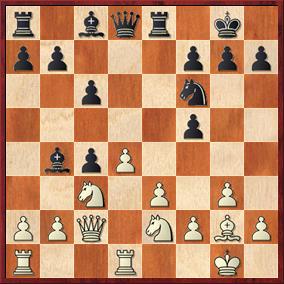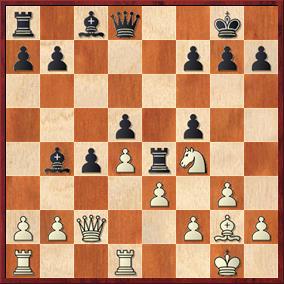First of all, I won the game. So don’t get the wrong impression from the title of today’s post. In round five of the Kolty Chess Club championship, I defeated Michael Ho with the Black pieces to improve my record to 4-1, still within striking distance of the leader. (More about that below.)
However, I got lucky because I made a mistake in the opening that could have allowed Ho to get a clear advantage. Mistakes almost always come because of flawed thought processes, so it might be interesting to some of you to see what I did wrong.

FEN: r1bqr1k1/pp3ppp/2p2n2/5p2/1bpP4/2N1P1P1/PPQ1NPBP/R2R2K1 b – – 0 12
White has just played 12. Rfd1, hinting strongly at a desire to break open the position with d4-d5. The most natural response seems to be 12. … Be6 but I didn’t like this, because 13. Nf4 renews the threat and after 13. … Nd5 now White gets excellent play with 14. Nxe6 fe 15. e4, when Black’s pawn formation is a mess.
The computer thinks that several moves are about equally good here, but its slight preference is 12. … Bxc3, a move I didn’t seriously consider because it trades off my “good” bishop. But perhaps I should have asked: What is this bishop doing, anyway? By playing 12. … Bxc3 13. Nxc3 I do accomplish one good thing – I take the move Nf4 out of the picture, so now I can play 13. … Be6. Now it will be very hard for White to win back his gambit pawn.
But both 12. … Be6 and 12. … Bxc3 involve making concessions to White, and I saw a move I thought I could play without making concessions: 12. … Nd5? What did I overlook?
The main variation that I considered was 13. Nxd5 cd 14. Nf4, when I had a surprise in mind for White: the Petrosian-esque exchange sacrifice 14. … Re4?! (diagram)

FEN: r1bq2k1/pp3ppp/8/3p1p2/1bpPrN2/4P1P1/PPQ2PBP/R2R2K1 w – – 0 15
The computer is very skeptical of this and gives White a slight edge. I’d be interested in readers’ thoughts on what it takes to make a “Petrosian sacrifice” work. I thought that Black’s two bishops, White’s weak light squares and Black’s impressive pawn center (transforming the weak, in-the-way f-pawn into a strong point on e4) were easily adequate compensation for the exchange sac.
But when I look at the position more objectively, I can see why the computer isn’t so enthusiastic. First, White has a number of useful moves he can play before taking, like a3 or h4. But even if White takes straight away, 15. Bxe4 fe, is Black’s game so good? After 16. Qe2, where does the light-squared bishop go? The problem, I think, is that White actually has the best minor piece on the board, the knight on f4, which hampers any efforts by Black to attack on the light squares. And Black’s development is quite substandard. The Q, QR and QB have not moved yet, and the KB is out in no man’s land, doing nothing. Usually it’s not a very good idea to sacrifice material for an attack when you haven’t developed anything yet.
But there’s an even bigger flaw with 12. … Nd5? After 13. Nxd5 cd White can play 14. Qa4! and win his pawn back! The Black queen is overloaded, having to defend e8 and d5, and there is no time to deal with this problem because the bishop is also hanging on b4. All of Black’s self-inflicted weaknesses are coming home to roost. After 14. … a5 15. Bxd5 White recovers his pawn absolutely for free, and the c4 pawn is also critically weak for Black. Not to mention the b7 pawn.
Luckily, my mistake went unpunished. My opponent played 13. a4? instead, which is in itself an instructive mistake. This move shows that he is obsessed with preventing … b5, but it creates a permanent hole on b4 (which I made very good use of later in the game, bringing my knight to b4 and d3). White failed to realize the tactical opportunities created by Black’s awkward and delayed development. After his 13. a4 I breathed a sigh of relief and played 13. … Be6, after which he never again had a serious chance to win back his gambit pawn.
Lesson learned: Finish your development, even if you do have to make some concessions. As Steinitz said, a pawn is worth a little trouble.
The win against Ho put me into a pretty good position in the tournament. Eric Steger continued to do his Bobby Fischer impersonation, defeating Mike Splane to run his record to 5-0. So far it’s been a dream tournament for him, as he has now defeated the #1, #2, and #3 seeds. This is lucky for me too, because he has taken out the three players who would (before the tournament) have been considered my chief competitors.
I’m in a three-way tie for second, with Paulo Santanna and Shreesh Nanda, at 4-1. Because I’m the highest-rated of the three, the logical pairing for next round would have me playing against Steger and Santanna playing against Nanda. If I can get the job done against Steger, then it could be a very interesting last round with three people tied at 5-1. Steger would still have very strong tiebreaks, so he would still have the inside track to win the tournament, I think. But let’s not worry about that yet. As athletes are fond of saying, let’s just take one game at a time.



{ 2 comments… read them below or add one }
I want to give credit where credit is due. Eric Steger played much better than I did and clearly deserved to win our game. It was one of those games where losing teaches you a lot, so I wasn’t all that unhappy afterwards.
Good luck on Thursday,
I think after 12. … Be6 13. Nf4 Nd5 14. Nxe6 fxe6 15. e4 the quiet retreat 15. … Ne7 gives black a good game.